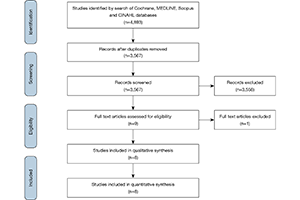Domino heart transplant following heart-lung transplantation: a systematic review and meta-analysis
Abstract
Background: The domino-donor operation occurs when a “conditioned” heart from the heart-lung transplant (HLT) recipient is transplanted into a separate heart transplant (HT) recipient. The purpose of this systematic review was to investigate the indications and outcomes associated with the domino procedure.
Methods: An electronic search was performed to identify all prospective and retrospective studies on the domino procedure in the English literature. Eight studies reported 183 HLT recipients and 263 HT recipients who were included in the final analysis.
Results: HLT indications included cystic fibrosis in 58% (95% CI: 27–84%) of recipients, primary pulmonary hypertension (PPH) in 17% (95% CI: 12–24%), bronchiectasis in 5% (95% CI: 3–10%), emphysema in 5% (95% CI: 0–45%), and Eisenmenger’s syndrome in 4% (95% CI: 2–8%). HT indications included ischemic heart disease in 40% (95% CI: 33–47%), non-ischemic disease in 39% (95% CI: 25–56%), and re-transplantation in 10% (95% CI: 1–59%). The pooled mean pulmonary vascular resistance (PVR) in HT recipients was 3.05 Woods units (95% CI: 0.14–5.95). The overall mortality in the HLT group was 28% (95% CI: 18–41%) at an average follow-up of 15.68 months (95% CI: 0.82–30.54), and 35% (95% CI: 17–58%) in the HT group at an average follow-up of 37.26 months (95% CI: 6.68–67.84). Freedom from rejection in HT was 94% (95% CI: 75–99%) at 1 month, 77% (95% CI: 30–96%) at 6 months, and 41% (95% CI: 33–50%) at 1 year.
Conclusions: The domino procedure appears to be a viable option in properly selected patients that can be performed safely with acceptable outcomes.
Cover






